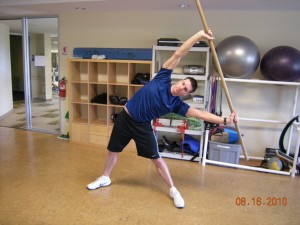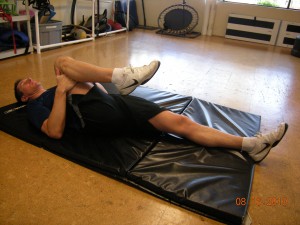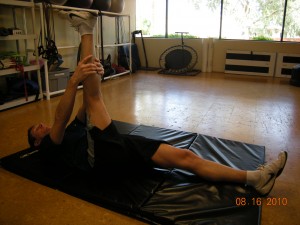Lateral Bend
The Lateral Bend is a great stretch to open up your lats, low back, abdominal muscles, and depending on how tight you are, your inner thigh.
Start by holding a dowel, broom stick, golf club, what ever you may have. Your hands should be wide so that you form an “X” with your arms and legs. Your hands should be above your head. Your legs should be wide and your toes open about 45 degrees
Before you start to bend to the side notice the space between my upper arm and head. That space should remain constant throughout the stretch. Exhale as you bend to one side hold for 5 seconds, then bend to the other side and hold for 5 Seconds. Repeat 4 times on each side.
Lying Spinal Rotation Stretch
This picture shows the end position of this stretch. To start lye on your left side. Your left leg should be straight. Bring your right leg across your body to a 90 degree angle. Your right leg should also be straight. Put your left hand on top of your right leg just above the knee. Raise your right hand to the ceiling then let it start to fall to the floor behind you. The goal is for your right shoulder to rotate around to the floor. If it doesn’t don’t worry about it for now, just know that’s the goal. Hold for 30- 60 seconds. Breath deeply and try to relax and get comfortable. Before your repeat on the other side. Lye on your back and pull both knees into your chest. Repeat 2-3 times on each side.
Quadriceps Stretch
I’m showing two Quadriceps Stretches here. The one on the left requires that you have access to a gym or equipment and home, the one on the left doesn’t
Starting with the Quadriceps Stretch on the left. You’ll need a step and a pad for your knee. Place on of your feet on the step, you should be on the ball of your foot. Simply lower yourself down to the ground so that your back knee is on the pad. This position will stretch your quadriceps and possibly your hip flexor as well. To increase the stretch raise the hand that’s on the same side as the knee on the pad, overhead.
The Quadriceps Stretch on the right is pretty simple. Grab your ankle and pull it to your glutes (butt). If you have trouble standing on one foot. You can support yourself by holding onto a chair or counter. If your Quadriceps are too tight for you to grab your ankle, then wrap a towel around your ankle and use that to pull your ankle toward your glutes. Hold each Stretch for 30-6- second and repeat 2-3 times.
Downward Dog
The Downward Dog is rooted in Yoga. It’s a great full body stretch. It also helps to develop so strength and stability in the shoulders. This picture show the end position. To start you want to get onto you hands and knees, with your hands directly under your shoulders and your knees directly under your hips. This is the same start position I cover with Pointers in Tip #9
From that position lift your hips straight up to the ceiling. Keep your legs straight and press your heels into the ground. Now pretend that there is a string connecting your armpits to your ankles. Shorten that string. This will help to open up space in your shoulders.
Hold for 30 to 60 seconds and repeat 2-3 times.
Add these four stretches to the stretches I covered in Tip #5. Do all eight stretches ad least once everyday. Twice a day is optimal. Watch the video below to learn more about how to correctly perform these stretches, enjoy and I’ll be back tomorrow with Tip #27
[youtube]http://www.youtube.com/watch?v=hOngfJvAo_w[/youtube]











